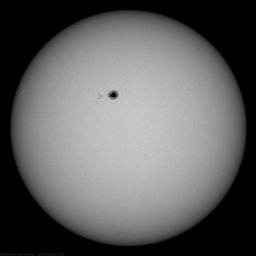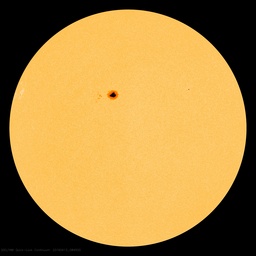Space Weather Reports and Storm Warnings
You can now subscribe to our AFFECTS space weather reports and storm warnings newsletter here.
You can now subscribe to our new feed "AFFECTS space weather reports and storm warnings" to keep informed about severe space weather conditions. Subscribe here.
PLEASE NOTE: When using SAFARI the rss feed might be displayed in your MAIL account. Additionally, it does not work with GOOGLE CHROME.
Last update: 13/04/2016 by Volker Bothmer (VB)
General Note: Magnetic conditions on the Sun under circumstances might change within a few hours. We'll only update this page in case of a major event.
13/04/2016 - issued by Volker Bothmer
Large AR2529 is now reaching a position facing the Earth. It is a potential source for fast CMEs causing major space weather effects during the next days and likely further on in time when its coming back after 27 days. Large solar storms often occur 2-3 years after sunspot maximum when the active regions progress towards lower heliographic latitudes.
June 25, 2015 - issued by Volker Bothmer, DDC run by Adam Pluta, CME speed calculation by Niclas Mrotzek
Active region 12371 located now near N11 W41 released a further flare and CME at about 08:15 UTC (Coordinated Universal Time) on June 25, 2015. Based on the DDC calculations the CME has an apex speed above 1700 km/s. However, the core of the CME is not expected to hit Earth, but a shock-flank passage with a speed of about 800 km/s is likely. The arrival time is determined near 02 UTC, i.e. 04 CEST, on June 27, 2015. The CME is of BS-type WSE. Under good weather conditions polar lights are expected to be seen in the sky above northern Europe. Geomagnetic Kp levels might reach 8- and above.
June 21, 2015 - issued by Volker Bothmer
Active region 12371 located now near N12 E13 released a CME at about 02:30 UT on June 21, 2015. Based on the DDC calculations the CME is expected to arrive at Earth on June 22, around 16 UT, i.e. 18 CET with a speed of about 800 km/s. The CME's magnetic field configuration is of type NWS, peak type of the storm is thus expected near midnight on June 22. If skies are clear polar lights may be seen in the sky above northern Europe. The storm is not expected to have major impacts on technological systems. Geomagnetic Kp levels may exceed 8-.
June 19, 2015
Growing sunspot region 12371 located near N13 E45 released a flare and CME at about 4.30 pm on June 18, 2015. The estimated speed of the CME apex was 1.000-1.300 km/s. Based on the source region location on the Sun no major effects at Earth are expected. It will be important to watch out for the magnetic field evolution of this region whilst it passes central meridian with respect to Earth. The region has the potential for further strong solar storms, i.e. fast CMEs and intense flares.
March 23, 2015
On March 15, 2015 a frontside halo CME has been observed by SOHO/LASCO at about 01 UT in association with a flare in AR 12297 at 00:36-00:45 UT at S16, W26 and the activation of a filament West of and adjacent to AR 12297 centered at location S18, W39. The calculation of the CME speed yielded 1165 km/s and from the DDC simulation an arrival time of March 17, 04-08 UT was determined. The CME speed at L1 was estimated to be 600-730 km/s. How close this forecast was to the actual arrival time can be seen by inspecting the solar wind plots provided under "Services". This event happened while we were on travel to Washington, DC for the Solar Probe Plus CDR meeting so the forecast has not been placed online. So far AFFECTS is not providing 24/7 services. Nonetheless if there would have been severe threats to technical systems we would have been in charge.
November 13, 2014
Big sunspot region 2192 reappeared at the Sun's east limb. Since most intense solar storms originate from regions that were already seen during the previous solar rotation, it is highly likely that it will cause space weather events at Earth in the time period November 18 to 25. Image courtesy NASA, SDO/AIA consortium.
September 11, 2014
An X1.6 (R3) flare occurred disk centered at N14E05 on September 10, 2014 around 17:30 UT. The AFFECTS 3-D CME analysis yields an average propagation speed to earth of 1130 km/s. The arrival time at earth is calculated to 07:37 CET on September 12. Its speed in earth orbit is estimated to 941 km/s, the maximum Kp-value to 9. Based on the magnetic configuration of the CME, which is classified as a SEN flux rope type according to the Bothmer & Schwenn scheme, the main phase of the storm will be from 08 to 20 CET on September 12. Visibility of Aurora in central Europe is possible after sunset on September 12. Please refresh your browser to play the movie at the bottom created with the ESA jhelioviewer software. Images and movie courtesy of the NASA SDO and SOHO consortia.
January 8, 2014
Analysis of the CME speed with the multipoint CAT method yields 3129 km/s for the central part of the CME leading edge. The speed of the CME portion traveling to Earth is calculated to 1663 km/s. Applying the BHV-method yields an arrival time of January 9, 03 CET at Earth with a speed of about 1000 km/s. This is close to the first estimate.
January 8, 2014
The CME structure and speed is currently analysed by the AFFECTS team in 3D to correct for projection effects. The near Sun speed could have been off by a factor of about 1.5. We will post the result updates as soon as they have been derived as well as corresponding movies and images.
January 7, 2014
An X1 class flare occurred in active region 1943, located slightly southwest of the large sunspot region 1944. The peak emission time of the flare at 18:32 UT was followed by post-eruptive arcades around 19 UT in association with a fast CME (see STEREO image). A quick analysis of STEREO A COR 2 data yields that the speed of the earthward directed portion of the CME was about 1500 km/s. From the BHV-method we determine an arrival time at Earth on January 9, 5 a.m. CET. From the magnetic field structure of the CME source region a NES magnetic flux rope type CME is expected according to the BS-scheme. The estimated speed at 1 AU should be around 1000 km/s with a B-field of about 30 nT. The peak geomagnetic storm time at Earth is expected to occur after 5 p.m. CET on January 9. Kp-values of above 8 are possible. Aurorae might be seen in northern Europe after sunset on January 9 until the morning of January 10 under clear sky conditions.

